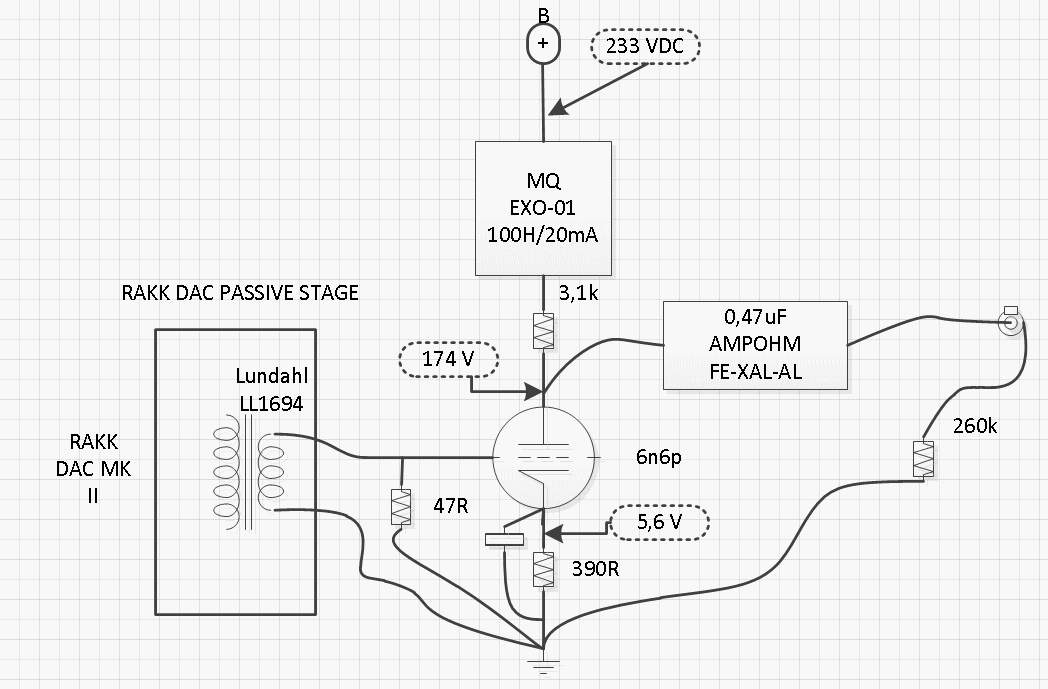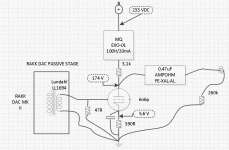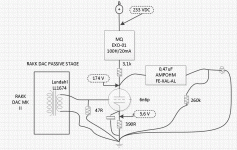In my case. I decided to add an active stage after the RAKK DAC passive I/V section I have. I first lowered the resistor after the LL1674 transformers to 47 Ohm. And then added a 6N6P SRPP stage.
I got what I wanted in terms of speed. But something was amiss. No musicality. Ripped out one 6N6P and converted the SRPP to plate loaded 6N6P. The sound really came to life.
I'll pick the plate loaded version of the SRPP any day of the week. YMMV, IMO and all that.
PS. Bypass cap is 100uF/10V

I got what I wanted in terms of speed. But something was amiss. No musicality. Ripped out one 6N6P and converted the SRPP to plate loaded 6N6P. The sound really came to life.
I'll pick the plate loaded version of the SRPP any day of the week. YMMV, IMO and all that.
PS. Bypass cap is 100uF/10V
Attachments
Last edited:
Do the transformer and 47R make up enough grid leak resistance? Seems low to me.
It's cathode biased so the resistance in the grid circuit can be anything from zero to the maximum acceptable grid resistance for the type of tube used.
I like choke loading as well and use it in some of my driver stages. The next phono stage may have them as well - the current one uses tube based gyrators.
A good idea would be to replace the anode choke with an output transformer.This would allow to throw away the coupling cap
I did that after my RAKK dac passive I/V. I had a single 6J5 drive the SILK 941 but it lacked speed in the low end. The circuit attached is what I am working on now, a few solder point and it will be up and running. I found that driving SILK 941 with low Z really improved speed/ attack in the low end but some of the resolution/ microdetail got lost adding more stages and a coupling cap. I think 6V7g/ecc88 won´t be the last attemt I do, and 6n6p driving my 941 by anode is up for a go next time.
Attachments
Hi andRookie
Isn't 210V too much for the ECC88 as the datasheet says max 130V plate-cathode.
Haven´t thought of that. During the test I used a 6N1P and it did not protest. I see I should just keep using it and not burn my ecc88s. Thanks!
It's cathode biased so the resistance in the grid circuit can be anything from zero to the maximum acceptable grid resistance for the type of tube used.
I learn something new here every day
So I guess it's a matter of matching the resistor to the transformer impedance?
Well yes, you'd use something in the kΩ range if it is passive. But I wanted the output stage to have a reasonable output similar to that of the passive stage. Maybe it is even lower I'm not sure. This way I guess the final gain is slightly lower than that of a typical cd player output.I'm working on a similar project. So I need to ask why 47R.
Resistors after the I/V transformer is used to be in the KΩ range.
I made a drawing error with the 260k resistor. And the I/V transformer is a 1674 ofcourse and not a 1694.
Attachments
I suppose so. I have so many projects still and funds are low. Plus I am very happy with the sound this way it's hard to believe it could be improvedA good idea would be to replace the anode choke with an output transformer.This would allow to throw away the coupling cap
Last edited:
I see, but I think that LL-1674 needs to see much higher impendance. And if you decide to use an output transformer you can still lower the output of the active stage throw the turns ratio.
F.e. LL-1689 allows 18:2 and 18:1 terminations, plus the benefits of lower output impendance.
F.e. LL-1689 allows 18:2 and 18:1 terminations, plus the benefits of lower output impendance.
I see, but I think that LL-1674 needs to see much higher impendance.
Have not tried low sec. load on my LL1674, but on my SILK 941 to low sec. load sounds REALLY dull.
I suppose so. I have so many projects still and funds are low. Plus I am very happy with the sound this way it's hard to believe it could be improved.
Bas ... what about rewiring the 6N6 again as SRPP and using the choke as load between the tubes? I am super-happy with my 6CG7 wired this way.
Bas ... what about rewiring the 6N6 again as SRPP and using the choke as load between the tubes? I am super-happy with my 6CG7 wired this way.
I've used this configuration successfully to drive 2A3 and 45 amongst other types with the 6SN7 (you need a lot of inductance).. Incidentally this is the choke based analog of a conventional mu follower - and it will give comparable gain. Choke DCR can be used as part of the resistance required to bias the upper tube in the pair. (I add some additional series resistance as required.) This circuit canl swing appreciably more voltage on a given supply voltage than a conventional mu follower. (Due to the low voltage drop across the choke as opposed to the "load" resistor between the follower portion and the CC portion in the mu follower configuration which drops appreciable DC across it.)
Last edited:
I am using a EXO99 (by MQ) for a whopping 150H. Its DCR is 510 ohm which nicely biases the 6CG7 at 10mA or so ... perfetto! I tried mu-followers quite a long time ago but I didn't like them and shortly switched to a pentode loaded triode rewiring a few pins. This SRPP is (soundwise) better.
Now, back to present days. I did tried also cascoded DN2540s between the (SRPP) tubes and they sounded pretty much the same as the choked SRPP (is there any specific name for this SRPP on steroids?). Voltage drop for the FETs was a merely 4-5V so maybe not enough. Residual hum was slight higher with CCS and I found it was oscillating at 180kHz. Source of the instability was the CCS but I could not tame it. I switched back to the choked SRPP, I will investigate the CCS'ed SRPP later on.
Hum out of a 5k:500 OPT is 115uV at 120Hz with a simple 6X5GT-4.7uF-10H-100uF, almost inaudible in my headphones but I left a 30-40V headroom in the PSU to add a regulator in the future. Tubes is heated on AC and 60Hz residual noise is 30-50uV.
Work in progress ... oktal sockets in place to give 6SN7s a try
Now, back to present days. I did tried also cascoded DN2540s between the (SRPP) tubes and they sounded pretty much the same as the choked SRPP (is there any specific name for this SRPP on steroids?). Voltage drop for the FETs was a merely 4-5V so maybe not enough. Residual hum was slight higher with CCS and I found it was oscillating at 180kHz. Source of the instability was the CCS but I could not tame it. I switched back to the choked SRPP, I will investigate the CCS'ed SRPP later on.
Hum out of a 5k:500 OPT is 115uV at 120Hz with a simple 6X5GT-4.7uF-10H-100uF, almost inaudible in my headphones but I left a 30-40V headroom in the PSU to add a regulator in the future. Tubes is heated on AC and 60Hz residual noise is 30-50uV.
Work in progress ... oktal sockets in place to give 6SN7s a try
An externally hosted image should be here but it was not working when we last tested it.
- Status
- This old topic is closed. If you want to reopen this topic, contact a moderator using the "Report Post" button.
- Home
- Amplifiers
- Tubes / Valves
- Plate loaded 6N6P over SRPP 6N6P any day of the week...

